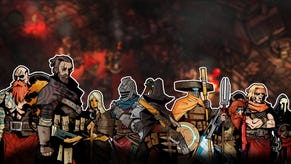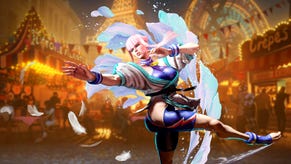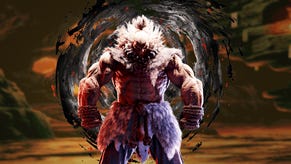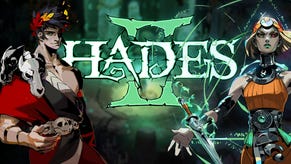Street Fighter 5 Champion Edition Roundtable: A Challenger Heads Into Its Final Round
Mike and Eric sort out their feelings on where Street Fighter 5 stands with the release of its latest collection.
This article first appeared on USgamer, a partner publication of VG247. Some content, such as this article, has been migrated to VG247 for posterity after USgamer's closure - but it has not been edited or further vetted by the VG247 team.
It feels like another era is coming to an end. Today marks the release of Street Fighter 5: Champion Edition, which contains all the characters, costumes, and tweaks added to the game since its 2016 launch. Street Fighter 5's launch was a stumble for the series, a full $60 price tag on a barebones package. Since then, Capcom has committed to improving the fighter.
Champion Edition is the marker of Capcom's improvements, four years and four season passes of characters later. The roster has grown with returning favorites like Sagat and Blanka, and wholly new entrants like Lucia and Menat. 39 characters, 34 stages, and over 200 costumes are packed into Champion Edition's release.
Those years of change haven't all been kind to Street Fighter 5 though. As the tier lists have shifted, so too has Street Fighter 5's place in the fighting game community. It's still Street Fighter, sitting in a comfortable spot on Evo 2020's main stage, but its place as the closing game of the competition has been overtaken by Super Smash Bros. Ultimate. USgamer's fighting fanatics, Mike Williams and Eric Van Allen, tackle a few questions about Street Fighter 5's current state and its future.

Do you think Street Fighter 5 ever recovered from launch?
Mike Williams: Not really. The feature-light launch of Street Fighter 5 was very disappointing. I remember reviewing it at the time and simply wondering why it was missing all of the hallmarks of a proper prestige fighting game. The story mode at the time was lackluster, there was no character-specific training mode, Challenge Mode wouldn't be released for some time, and the online options were sparse. For $60, the launch version of Street Fighter 5 was kind of absurd. It also probably didn't help that the PS4 version of Ultra Street Fighter 4 came out a year earlier and was in great shape by the time SF5 released.
Eric Van Allen: It did, but not in the public eye. I think most people who heard about Street Fighter 5's launch issues made up their mind early and moved on. A lack of story mode or really much to do at all besides play online isn't going to retain a casual player, the kind who would pick up SF5 on name alone. But for the diehards, I think it ultimately got to a good place; or at least, it cleared a bar that Street Fighter game should clear. It's a shame that it's only reached it near the likely end of the game's lifespan, but better late than never.
Does Street Fighter 5 feel like a more approachable or watchable game?
Mike Williams: It's a better looking game overall and I like many of the new character designs?—many of the characters in SF4 looked weird?. I understand the aims of Street Fighter 5, trying to simplify the experience and make it more aggressive, but there's something to be said about keeping your community happy. SF5 sanded off the rough edges of characters, but also removed some of the more interesting ways players could utilize those characters. The trick with any fighting game is making it easy for neophytes to play, while allowing further outlets for your veteran players, and I think SF5 stumbled in that regard.
Eric Van Allen: Yes and no. In terms of watchable, it's about the same as Street Fighter 4. The look is good, and matches generally have a good pace and level of hype for spectators. As for approachable, Street Fighter still feels like it's lagging behind most other games in this area. While there are some basic combo tutorials now, it doesn't have quite the in-depth tutorial system that Mortal Kombat or Guilty Gear have. The V-System also added a lot to keep track of—more on that further down—that I think ultimately offered too many options, even if you rarely engage with some of them once you're sufficiently proficient.

Who were the standouts of Street Fighter 5's roster?
Mike Williams: For the tournament set, it definitely feels like Rashid is probably the best all-new character in the bunch. There's so much interesting Rashid play at the tournament level. I also think that Necalli, being a very aggressive character, was a lot of fun for a while. Personally, I'm a big fan of Zeku and I was glad to see my man Cody back from Street Fighter Alpha 3, even if he doesn't play entirely the same. I'm actually pretty happy with the roster where Capcom has it now.
Eric Van Allen: Of the newcomers, Rashid and Menat are my immediate standouts. Rashid is just a blast to play, and really gels with the overall cast. Menat was the most interesting of SF5's post-launch DLC, and also stood out a lot more than some other DLC fighters like Falke or Ed. A few revisions of old characters were pretty great, too; as Mike mentioned, Cody is great to see again, and other Alpha classics like Karin and R. Mika really liven up the roster.

What was the best new thing Street Fighter 5 added? Worst?
Mike Williams: I'll just stick to the worst: Fight Money. The idea is sound, offering players a way to unlock characters and costumes simply by playing through the game. Unfortunately, earning fight money is such a goddamn slog that I'd much rather they have a simpler system. I'd stick with the individual purchase and character pass model, as it's been proven to work for other fighting games.
Let players unlock other costumes through story and challenge modes, and sell others like Capcom currently does. People seem largely fine with spending $5.99 a pop for Tekken 7 characters, or the utter microtransaction madness of Dead or Alive 6. So, just sell us the characters. Fight money just makes the entire system too muddy and unsatisfying.
Eric Van Allen: The best thing Street Fighter 5 did, in my opinion, was ditch the incremental versions. It's nice that, even if you never engaged with the DLC fighters, you got every balance update for free. Paying for big gameplay overhauls was a dated model, and I'm glad it's gone.
That said, I agree with Mike that the way SF5's free-to-play option, a.k.a. Fight Money was implemented dragged it down. I ended up buying passes because I didn't want to spend the hours building up the in-game cash to unlock a fighter. It's better to just stick to passes, I think, or find some other way to meter out free upgrades.

Does the service game model work for Street Fighter?
Mike Williams: I think fighting games as a whole have slotted into the service game model very well. If you love a game, you're generally willing to support it with further purchases. The fighting game community has taken to the character pass model well, with annual bundles of four or five characters keeping the game alive.
At the end of the day, everyone seems to have come around to Dead or Alive's way of thinking: people will pay good money for cool costumes on their favorite characters. I think some of that should be unlocked within the game itself, but themed outfits and more? The community has shown that it's willing to pay. I don't see why Street Fighter would need to be any different.
Eric Van Allen: Off of what I said above, absolutely. It's really the path forward for all fighting games at this point. Long before Fortnite ever dropped onto the scene, your fighting game of choice was a "forever game". You didn't play other games, and while you might dabble in another fighting game or two, your main was your main. Service models and platforms can embrace that, offering more updates and cool updates like seasonal costumes or rewards for players. As long as its implemented well—hopefully better in the next installment—this model works for Street Fighter.
What do you think of the V-System, overall?
Eric Van Allen: It was an interesting choice, but I ultimately think I want to see the V-System go, or at least undergo some massive overhauls in the future. It's overly complicated for newcomers, having to manage two meters, yet at the upper levels you can usually rely on having an install to buff up your fighter once a round. Unlike other attempts to have multiple bars in Street Fighter to manage, I don't think the V-Skills or V-Triggers added much variety, and instead it felt like it set predetermined destinations for some characters' playstyles. It needs an overhaul at the very least.
Where would you rank SF5 in the series?
Mike Williams: Being 100% honest, the Street Fighter Alpha series is still the pinnacle of Street Fighter for me. I know that's probably weird to some folks, but Street Fighter Alpha 2 is probably my favorite title in the series, if we don't count the PlayStation version of Street Fighter Alpha 3, which added the sublime World Tour mode. After that, I'd probably Street Fighter 3: Third Strike, Ultra Street Fighter 4, Street Fighter 5: Arcade Edition, and then Street Fighter 2 Turbo: Hyper Fighting. (Look, I just dislike going back to play the original.)
Eric Van Allen: Street Fighter 3: 3rd Strike is still my personal favorite, but every Street Fighter has its own flavor. Alpha feels different from 2, which had various versions that all play in similar-yet-different ways.
I don't think I'll want to return to Street Fighter 5 very often like I do with the other games, because it almost feels transitional, like it was the halfway step towards whatever the next big Street Fighter evolution will be. And I think it will be interesting; aside from the lessons Capcom has likely learned from developing SF5, other fighting games have been evolving at a rapid pace as well. But while I will still nostalgically boot up 3rd Strike or put some quarters into a Street Fighter 2 machine, I don't think I'll be going out of my way to keep playing Street Fighter 5 years from now.

Do you think the PlayStation exclusivity helped or harmed Street Fighter 5?
Eric Van Allen: I'm not sure it hurt Street Fighter 5 all that much in the end. While the Xbox 360 felt like the most populated hub for SF4, the PlayStation was the clear frontrunner this last console generation. In fact, SF5 going to PS4 might have helped ultimately swing the genre in that direction; now, you see new fighting games like Granblue Fantasy: Versus going only to PS4, and tournament standard became the PlayStation over the Xbox (unless you were playing Killer Instinct). If anything, I think it just harmed the Xbox.
Mike Williams: I agree that in the console competition between PlayStation 4 and Xbox One, Street Fighter 5 wasn't hurt that much. It's when you add the Nintendo Switch into the equation that things change. Take Street Fighter 4, for example. The original release sold 3.4 million units on PlayStation 3 and Xbox 360. Super Street Fighter 4 sold another 1.9 million and Ultra Street Fighter 4 did 1.4 million. And at the end, there's Super Street Fighter IV 3D Edition, which only came out on 3DS, selling 1.3 million.
So a cast-off release on a weaker portable console sold nearly as much as the additional version. Now imagine that Street Fighter 5 could make its way to Switch? I think that's where Street Fighter 5's PlayStation exclusivity has hurt it a bit on the console side of things.
Street Fighter 5: Champion Edition is out today on PlayStation 4 and PC (Steam).










